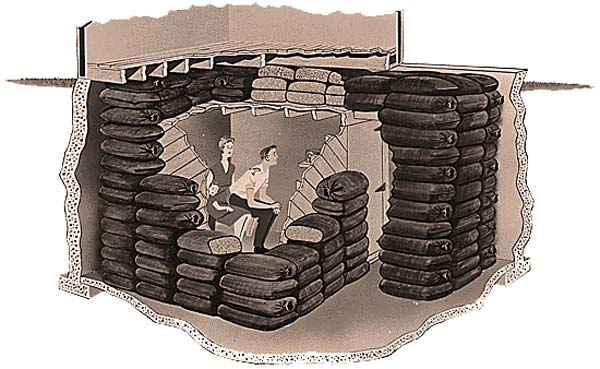How To Survive Radioactive Fallout
There are a number of ways that we can be exposed to radioactive fallout. Some people say the chances are slim and some people say that the threat is imminent. Depending on the situation, your location and your preparedness there are a number of ways that we can avoid being exposed to it’s deadly effects. This article addresses how to effectively avoid contamination from fallout.
The Potential Sources
The 2 main sources of radioactive fallout come from nuclear weapon detonations and failed or failing nuclear reactors. In today’s current climate of perceived instability we are also led to believe that an additional source of radioactive contamination could come from dirty bombs.

In all cases of fallout, the contamination spreads downwind in a radioactive cloud that drops particles down to the ground in what is called a dusting. The fallout will be the most potent at ground zero. The resulting radiation cloud will drift across the landscape.
If it is a dirty bomb attack, the fallout will not be nearly as devastating as a tactical nuke. If you ever find yourself in the unfortunate circumstance of one of these attacks, get away from the blast as quick as possible and seek shelter. When it is not clear what is going on assume the worst and act accordingly. Move so you are not downwind from blast site. Cover yourself and breathe through a filter like a dust mask.
Get home if you can, assuming you have it prepared for emergencies. Wherever you end up, remove your outer layer of clothing and wash yourself as soon as possible. You’ll know how serious the threat is by checking in with the news (the T.V. will not work if the attack is a true nuclear assault).
Now if there is a nuclear weapon detonation then things are different, ie much worse. The hellscape aftermath of a nuclear attack won’t be described here but the should be noted.
Assuming you are outside of the kill zone you will need to evacuate or seek shelter immediately. It is the same with being downwind from a nuclear power plant meltdown. The intensity of radiation varies between attacks and accidents but the fallout is deadly either way.
The Fallout
In a nuclear blast, the worst fallout will begin just minutes after a blast depending on how heavy the particulates are. The lighter the fallout particles are the longer they linger in the air and drift. This will come down over a wide area and start within an hour of the blast. Everything will have a coating of radioactive dust. You want to avoid exposure for many reasons, you’ll either have a shortened lifespan from cancer or die relatively quickly.
The radiation of nuclear fallout does have a half life which is good to know. Ideally you’d want to wait a minimum of 3 days before leaving the shelter to be on the safe side. After only 2 days the radiation is only 1/100th as harmful as it was before.
The Shelter
Your main goal is to safely wait out the nuclear fallout in a shelter. Of course the shelter should be stockpiled with with food, water and comfort items. The shelter itself is also of vital importance. Your 2 main goals are to get as far away from the radiation as possible and put as much mass between you and the radiation as possible.
Shielding is the main concern. The home acts as the first line of defense but the materials are by no means enough to provide protection. Make sure the windows and vents are all closed. If a window is broken, and if you have time, cover it with anything from duct tape and plastic to plywood. You do not want to have wind blowing into your home as it can carry the radioactive dust.
Shelter Materials
The shelter in your home should be in the center of your basement away from the external walls. If you have window wells, cover the windows and fill the wells up with soil if you have time. The heavier and thicker the material you have insulating you from the outdoors the better. You need 1 foot of concrete to cut down the strength of radiation by 1/10th and you need 5 inches of solid steel to cut back the radiation by 99% of radiation.
Thick steel is expensive and it may be difficult to cast a concrete shelter within the center of your basement. To get the mass needed for sufficient protection, a good idea is to brace and stack brick & mortar walls (at least 16 inches thick) and top it with layered sheets of plywood. Line the top of the plywood with wide flat stone. Hire a local landscape contractor to get the ideal stone pieces suitable for your shelter. What is convenient here is that a crew of men will place the heavy stone for you for a reasonable price.
You’ll have to make sure the top of the shelter is supported enough to hold the weight of the stacked stones. To ensure that you will not be crushed by your own shelter, make the footprint 4’ x 8’ which is the dimensions of a standard sheet of plywood. The strength of three 1” thick sheets of plywood stacked is enough to support the weight of the stone shielding.
The structure should have a small opening to crawl into with a door to block it. Leave a small opening for airflow in the bottom and at the top of the wall. This shelter described above is my version of FEMA’s lean-to basement structure. The U.S. government has made sure that the plans are readily available online.
Alternate Location
If you cannot get to your home, then go into a designated fallout shelter underground or go to the center of a building, like a janitor’s closet. If you are in a high rise, go into the center of the building both horizontally and vertically, the ground floor is where the dust settles, but the upper floors (not the top floors) are relatively safer.
Conclusion
Remember that you will only need to shelter for 3 days. After that you can exit and either evacuate if you need assistance or regroup and begin cleaning up the mess. After a nuclear event there are many possible scenarios that could result, and there are many things that must be dealt with. There will be challenging times ahead, but surviving the fallout itself to see those days of difficulty is half the battle. Take plans to prepare, because in an event like this, there will be very little time to spare. You are either ready or not.
About The Author
Rich is a blogger living and writing from the front range of Colorado’s Rocky Mountains. He graduated cum laude from Bradley University with a B.A. in Political Science. For the last 8 years Rich has been assisting business owners with website development and online visibility. He currently writes for Green Guys located in Colorado.





